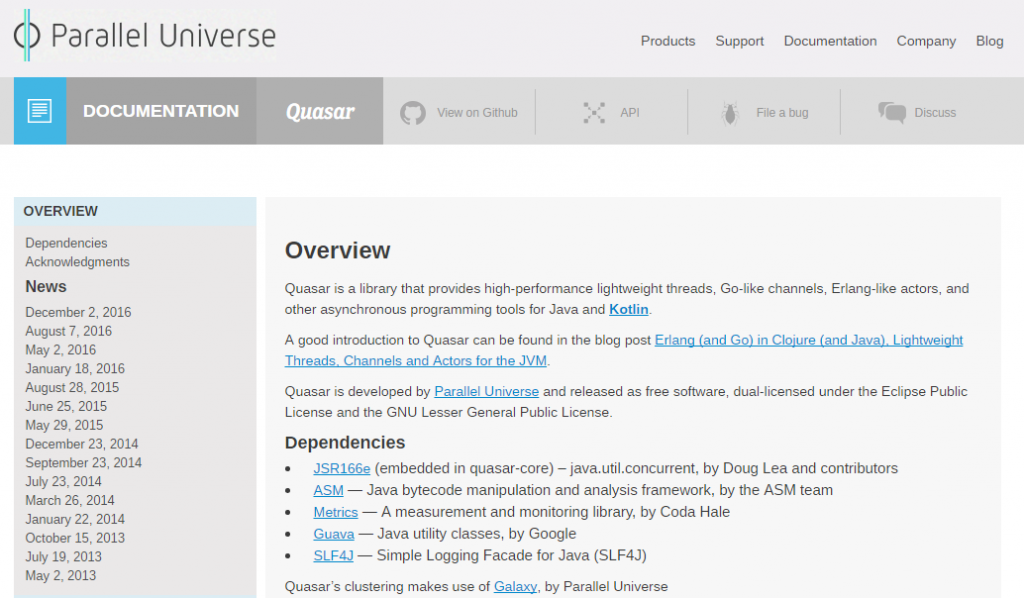
前一篇文章Java中的纤程库 – Quasar中我做了简单的介绍,现在进一步介绍这个纤程库。
Quasar还没有得到广泛的应用,搜寻整个github也就pinterest/quasar-thrift这么一个像样的使用Quasar的库,并且官方的文档也很简陋,很多地方并没有详细的介绍,和Maven的集成也不是很好。这些都限制了Quasar的进一步发展。
但是,作为目前最好用的Java coroutine的实现,它在某些情况下的性能还是表现相当出色的,希望这个项目能够得到更大的支持和快速发展。
因为Quasar文档的缺乏,所以使用起来需要不断的摸索和在论坛上搜索答案,本文将一些记录了我在Quasar使用过程中的一些探索。
1 Thread vs Quasar
虽然Java的线程的API封装的很好,使用起来非常的方便,但是使用起来也得小心。首先线程需要耗费资源,所以单个的机器上创建上万个线程很困难,其次线程之间的切换也需要耗费CPU,在线程非常多的情况下导致很多CPU资源耗费在线程切换上,通过提高线程数来提高系统的性能有时候适得其反。你可以看到现在一些优秀的框架如Netty都不会创建很多的线程,默认2倍的CPU core的线程数就已经应付的很好了,比如node.js可以使用单一的进程/线程应付高并发。
纤程使用的资源更少,它主要保存栈信息,所以一个系统中可以创建上万的纤程Fiber,而实际的纤程调度器只需要几个Java线程即可。
我们看一个性能的比较,直观的感受一下Quasar带来的吞吐率的提高。
下面这个例子中方法m1调用m2,m2调用m3,但是m2会暂停1秒钟,用来模拟实际产品中的阻塞,m3执行了一个简单的计算。
通过线程和纤程两种方式我们看看系统的吞吐率(throughput)和延迟(latency)。
|
1
2
3
4
5
6
7
8
9
10
11
12
13
14
15
16
17
18
19
20
21
22
23
24
25
26
27
28
29
30
31
32
33
34
35
36
37
38
39
40
41
42
43
44
45
46
47
48
49
50
51
52
53
54
55
56
57
58
59
60
61
62
63
64
65
66
67
68
69
70
71
72
73
|
public class Helloworld { @Suspendable static void m1() throws InterruptedException, SuspendExecution { String m = "m1"; //System.out.println("m1 begin"); m = m2(); //System.out.println("m1 end"); //System.out.println(m); } static String m2() throws SuspendExecution, InterruptedException { String m = m3(); Strand.sleep(1000); return m; } //or define in META-INF/suspendables @Suspendable static String m3() { List l = Stream.of(1,2,3).filter(i -> i%2 == 0).collect(Collectors.toList()); return l.toString(); } static public void main(String[] args) throws ExecutionException, InterruptedException { int count = 10000; testThreadpool(count); testFiber(count); } static void testThreadpool(int count) throws InterruptedException { final CountDownLatch latch = new CountDownLatch(count); ExecutorService es = Executors.newFixedThreadPool(200); LongAdder latency = new LongAdder(); long t = System.currentTimeMillis(); for (int i =0; i< count; i++) { es.submit(() -> { long start = System.currentTimeMillis(); try { m1(); } catch (InterruptedException e) { e.printStackTrace(); } catch (SuspendExecution suspendExecution) { suspendExecution.printStackTrace(); } start = System.currentTimeMillis() - start; latency.add(start); latch.countDown(); }); } latch.await(); t = System.currentTimeMillis() - t; long l = latency.longValue() / count; System.out.println("thread pool took: " + t + ", latency: " + l + " ms"); es.shutdownNow(); } static void testFiber(int count) throws InterruptedException { final CountDownLatch latch = new CountDownLatch(count); LongAdder latency = new LongAdder(); long t = System.currentTimeMillis(); for (int i =0; i< count; i++) { new Fiber<Void>("Caller", new SuspendableRunnable() { @Override public void run() throws SuspendExecution, InterruptedException { long start = System.currentTimeMillis(); m1(); start = System.currentTimeMillis() - start; latency.add(start); latch.countDown(); } }).start(); } latch.await(); t = System.currentTimeMillis() - t; long l = latency.longValue() / count; System.out.println("fiber took: " + t + ", latency: " + l + " ms"); }} |
运行这个程序(需要某种instrument, agent或者AOT或者其它,在下面会介绍),输出结果为:
|
1
2
|
thread pool took: 50341, latency: 1005 msfiber took: 1158, latency: 1000 ms |
如果使用线程,执行完1万个操作需要50秒,平均延迟为1秒左右(我们故意让延迟至少1秒),线程池数量为200。(其实总时间50秒可以计算出来)
但是如果使用纤程,执行完1万个操作仅需要1.158秒,平均延迟时间为1秒,线程数量为CPU core数(缺省使用ForkJoinPool)。
可以看到,通过使用纤程,尽受限于系统的业务逻辑,我们没有办法提升业务的处理时间, 但是我们确可以极大的提高系统的吞吐率,如上面的简单的例子将10000个操作的处理时间从50秒提高到1秒,非凡的成就。
如果我们将方法m2中的Strand.sleep(1000);注释掉,这样这个例子中就没有什么阻塞了,我们看看在这种纯计算的情况下两者的表现:
|
1
2
|
thread pool took: 114, latency: 0 msfiber took: 180, latency: 0 ms |
可以看到,纤程非但没有提升性能,反而会带来性能的下降。对于这种纯计算没有阻塞的case,Quasar并不适合。
正如官方所说:
Fibers are not meant to replace threads in all circumstances. A fiber should be used when its body (the code it executes) blocks very often waiting on other fibers (e.g. waiting for messages sent by other fibers on a channel, or waiting for the value of a dataflow-variable). For long-running computations that rarely block, traditional threads are preferable. Fortunately, as we shall see, fibers and threads interoperate very well.
2 Suspendable方法
Fiber中的run方法,如SuspendableRunnable 和 SuspendableCallable声明了SuspendExecution异常。这并不是一个真的异常,而是fiber内部工作的机制。任何运行在fiber中的可能阻塞的方法,如果声明了这个异常,就被叫做 suspendable 方法。 如果你的方法调用了一个suspendable方法,那么你的方法也是suspendable方法,所以也需要声明抛出SuspendExecution异常。
有时候不能在某个方法上声明抛出SuspendExecution异常,比如你实现某个接口,你不能更改接口的方法声明,你不得不使用其它的方法来指定suspendable方法。方法之一就是使用@Suspendable注解,在你需要指定的suspendable方法上加上这个注解就可以告诉Quasar这个方法是suspendable方法。
另一个情况就是对于第三的库,你不可能更改它们的代码,如果想指定这些库的某些方法是suspendable方法,比如java.net.URL.openStream()Ljava/io/InputStream;, 就需要另外一种解决办法,也就是在META-INF/suspendables和META-INF/suspendable-supers定义。
文件中每个方法占一行,具体(concrete)的suspendable方法应该写在META-INF/suspendables中,non-suspendable方法,但是有suspendable override的类、接口写在META-INF/suspendable-supers中(可以是具体类单不能是final, 接口和抽象类也可以)。
每一行应该是方法的签名的全称“full.class.name.methodName” 以及*通配符。
使用`SuspendablesScanner`可以自动增加你的方法到这些文件中,待会介绍它。
java.lang包下的方法不能标记为suspendable,其它的JDK方法则可以显示地在文件META-INF/suspendables和META-INF/suspendable-supers中标记为suspendable,并且设置环境变量co.paralleluniverse.fibers.allowJdkInstrumentation为true,但是很少这样使用。
还有一些特殊的情况也会被认为是suspendable的。
反射调用总是被看作是suspendable的。
Java 8 lambda也总是被看作suspendable的。
构造函数/类初始化器不能被标记为suspendable。
缺省情况下synchronized和blocking thread 调用不能运行在Fiber中。这是因为它们会阻塞Fiber使用的线程,导致系统处理变慢,但是如果你非要在Fiber中使用它们,可以可以将allowMonitors和allowBlocking传给instrumentation Ant task,或者将b、m传给Quasar Java agent。
3 Maven配置
Quasar依赖字节码的instrumentation, instrumentation用来修改字节码。 Quasar可以在运行时或者编译时修改字节码,下面介绍这几种实现。
1、Quasar Java Agent
Quasar java agent可以在运行时动态修改字节码,将下面一行加搭配java命令行中即可,注意把path-to-quasar-jar.jar替换成你实际的quasar java的地址。
|
1
|
-javaagent:path-to-quasar-jar.jar |
如果你使用maven的exec task,你可以使用maven-dependency-plugin为依赖设置properties,然后在插件exec-maven-plugin中引用quasar库即可。
详细配置可以参考Specifying the Java Agent with Maven:。
Quasar对gradle的支持比较好,你可以方便的使用gradle配置。
这是首选的一种方式,因为在某些情况下,比如你使用第三方的库,如comsat,它们只能使用这种方式配置。
2、AOT(Ahead-of-Time)
另外一种是在编译时的时候完成instrumentation。
它是通过一个Ant Task来完成的,所以对于Maven管理的项目来说,配置起来有些麻烦。
这个Ant Task是co.paralleluniverse.fibers.instrument.InstrumentationTask,包含在quasar-core.jar中。它接受一组(fileset)classes进行instrument,但并不是传给它的所有classes都需要classes进行instrument,只有suspendable方法才有可能被instrument。它还会进行优化,有些suspendable方法可能不需要instrument。
在Maven中配置起来有些复杂,如下面所示:
|
1
2
3
4
5
6
7
8
9
10
11
12
13
14
15
16
17
18
19
20
21
22
23
24
25
26
27
28
29
30
31
32
33
34
35
36
|
<plugin> <groupId>org.apache.maven.plugins</groupId> <artifactId>maven-antrun-plugin</artifactId> <executions> <execution> <id>instrument-classes</id> <phase>compile</phase> <configuration> <tasks> <property name="ant_classpath" refid="maven.dependency.classpath"/> <taskdef name="instrumentationTask" classname="co.paralleluniverse.fibers.instrument.InstrumentationTask" classpath="${co.paralleluniverse:quasar-core:jar:jdk8}"/> <instrumentationTask allowMonitors="true" allowBlocking="true" check="true" verbose="true" debug="true"> <fileset dir="${project.build.directory}/classes/" includes="**/*"/> </instrumentationTask> </tasks> </configuration> <goals> <goal>run</goal> </goals> </execution> </executions></plugin><plugin> <artifactId>maven-dependency-plugin</artifactId> <version>2.5.1</version> <executions> <execution> <id>getClasspathFilenames</id> <goals> <goal>properties</goal> </goals> </execution> </executions></plugin> |
Quasar官方并没有提供一个maven插件,好心的社区倒是提供了一个quasar-maven-plugin。所以你可以不用上面的写法,而是用下面简单的写法:
|
1
2
3
4
5
6
7
8
9
10
11
12
13
14
15
16
17
18
|
<plugin> <groupId>com.vlkan</groupId> <artifactId>quasar-maven-plugin</artifactId> <version>0.7.3</version> <configuration> <check>true</check> <debug>true</debug> <verbose>true</verbose> </configuration> <executions> <execution> <phase>compile</phase> <goals> <goal>instrument</goal> </goals> </execution> </executions></plugin> |
3、在Web容器中
如果你使用web容器使用基于Quasar的库comsat等,比如Tomcat,则比较棘手。因为你不太像将Quasar java agent直接加到tomcat的启动脚本中,这样会instrument所有的应用,导致很多的警告。
Comsat提供了Tomcat和Jetty的解决方案。
Tomcat
对于tomcat,你可以把comsat-tomcat-loader-0.7.0-jdk8.jar或者comsat-tomcat-loader-0.7.0.jar加入到tomcat的common/lib或者lib中,然后在你的web应用META-INF/context.xml中加入:
|
1
|
<Loader loaderClass="co.paralleluniverse.comsat.tomcat.QuasarWebAppClassLoader" /> |
Jetty
如果使用Jetty,则把comsat-jetty-loader-0.7.0-jdk8.jar或者comsat-jetty-loader-0.7.0.jar加入到Jetty的lib中,然后在你的context.xml中加入<Set name="classLoader">:
|
1
2
3
4
5
6
7
8
9
10
11
|
<Configure id="ctx" class="org.eclipse.jetty.webapp.WebAppContext"> <Set name="war">./build/wars/dep.war</Set> <!--use custom classloader in order to instrument classes by quasar--> <Set name="classLoader"> <New class="co.paralleluniverse.comsat.jetty.QuasarWebAppClassLoader"> <Arg> <Ref id="ctx"/> </Arg> </New> </Set></Configure> |
总之,通过实现一个定制的ClassLoader实现instrumentation。
4 Auto Suspendables Detection
quasar提供了一个ant task,可以实现自动侦测suspendable方法,并可以把它们写入到`META-INF/suspendables和META-INF/suspendable-supers`。
但是官方并没有详细的介绍,而且也没有相应的maven插件可以使用。
我们可以看看在gradle如何使用的,我们可以把侦测结果复制到maven中使用:
|
1
2
3
4
5
6
7
8
9
10
11
12
13
14
15
16
17
18
19
20
21
22
23
24
25
26
27
28
|
apply plugin: 'java'apply plugin: 'maven'group = 'com.colobu.fiber'version = '1.0'description = """"""sourceCompatibility = 1.8targetCompatibility = 1.8repositories { maven { url "http://repo.maven.apache.org/maven2" }}dependencies { compile group: 'co.paralleluniverse', name: 'quasar-core', version:'0.7.5', classifier:'jdk8' compile group: 'co.paralleluniverse', name: 'comsat-httpclient', version:'0.7.0' testCompile group: 'junit', name: 'junit', version:'4.12'}classes { doFirst { ant.taskdef(name: 'scanSuspendables', classname: 'co.paralleluniverse.fibers.instrument.SuspendablesScanner', classpath: "build/classes/main:build/resources/main:${configurations.runtime.asPath}") ant.scanSuspendables(auto: true, suspendablesFile: "$sourceSets.main.output.resourcesDir/META-INF/suspendables", supersFile: "$sourceSets.main.output.resourcesDir/META-INF/suspendable-supers", append: true) { fileset(dir: sourceSets.main.output.classesDir) } }} |
我们可以看一下官方的库comsat的一些`META-INF/suspendables`例子:
1、comsat-okhttp
/META-INF/suspendables:
|
1
|
com.squareup.okhttp.apache.OkApacheClient.execute |
2、comsat-httpclient
/META-INF/suspendables
|
1
2
|
org.apache.http.impl.client.CloseableHttpClient.doExecuteorg.apache.http.impl.client.CloseableHttpClient.execute |
5 故障检测
当前quasar依赖字节码的instrumentation,所以suspendable方法必须在运行之前进行标记。
Quasar开发组和OpenJDK协作,将在JDK9中移除这个限制,将会有效地自动地实现instrumentation。
如果你忘记将一个方法标记为suspendable (throws SuspendExecution、@Suspendable或者META-INF/suspendables/META-INF/suspendable-supers),你可能会遇到一些奇怪的错误。
环境变量co.paralleluniverse.fibers.verifyInstrumentation设为true可以检查未标记的方法。但是在生产环境中不要设置它。
UnableToInstrumentException异常表明quasar不能instrument一些方法如synchronized或者阻塞的线程调用。verbose(v), debug(d) 和 check(c)可以打印出详细信息。
更多的调试可以参考:troubleshooting。
6 其它
Fiber可以序列化。
Fiber也可以打印它的堆栈进行调试。
Fiber也有Actor和Channel的实现,并且可以运行在集群上。
转自:
http://www.importnew.com/23314.html
http://docs.paralleluniverse.co/quasar/#specifying-the-java-agent-with-gradle
附:
1 <!-- quasar-core --> 2 <dependency> 3 <groupId>co.paralleluniverse</groupId> 4 <artifactId>quasar-core</artifactId> 5 <version>${quasar.version}</version> 6 </dependency> 7 <!-- comsat-httpclient --> 8 <dependency> 9 <groupId>co.paralleluniverse</groupId> 10 <artifactId>comsat-httpclient</artifactId> 11 <version>${comsat.version}</version> 12 </dependency> 13 <!-- comsat-spring-boot --> 14 <dependency> 15 <groupId>co.paralleluniverse</groupId> 16 <artifactId>comsat-spring-boot</artifactId> 17 <version>${comsat.version}</version> 18 <exclusions> 19 <exclusion> 20 <groupId>org.slf4j</groupId> 21 <artifactId>log4j-over-slf4j</artifactId> 22 </exclusion> 23 </exclusions> 24 </dependency>